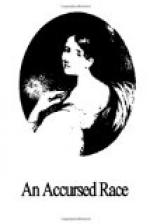by this unfortunate race—who were forbidden
to occupy land, or to bear arms, the usual occupations
of those times. They had some small right of
pasturage on the common lands, and in the forests:
but the number of their cattle and live-stock was
strictly limited by the earliest laws relating to
the Cagots. They were forbidden by one act to
have more than twenty sheep, a pig, a ram, and six
geese. The pig was to be fattened and killed
for winter food; the fleece of the sheep was to clothe
them; but if the said sheep had lambs, they were forbidden
to eat them. Their only privilege arising from
this increase was, that they might choose out the
strongest and finest in preference to keeping the
old sheep. At Martinmas the authorities of the
commune came round, and counted over the stock of
each Cagot. If he had more than his appointed
number, they were forfeited; half went to the commune,
half to the baillie, or chief magistrate of the commune.
The poor beasts were limited as to the amount of
common which they might stray over in search of grass.
While the cattle of the inhabitants of the commune
might wander hither and thither in search of the sweetest
herbage, the deepest shade, or the coolest pool in
which to stand on the hot days, and lazily switch
their dappled sides, the Cagot sheep and pig had to
learn imaginary bounds, beyond which if they strayed,
any one might snap them up, and kill them, reserving
a part of the flesh for his own use, but graciously
restoring the inferior parts to their original owner.
Any damage done by the sheep was, however, fairly
appraised, and the Cagot paid no more for it than
any other man would have done.
Did a Cagot leave his poor cabin, and venture into
the towns, even to render services required of him
in the way of his he was bidden, by all the municipal
laws, to stand by and remember his rude old state.
In all the towns and villages the large districts
extending on both sides of the Pyrenees—in
all that part of Spain—they were forbidden
to buy or sell anything eatable, to walk in the middle
(esteemed the better) part of the streets, to come
within the gates before sunrise, or to be found after
sunset within the walls of the town. But still,
as the Cagots were good-looking men, and (although
they bore certain natural marks of their caste, of
which I shall speak by-and-by) were not easily distinguished
by casual passers-by from other men, they were compelled
to wear some distinctive peculiarity which should
arrest the eye; and, in the greater number of towns,
it was decreed that the outward sign of a Cagot should
be a piece of red cloth sewed conspicuously on the
front of his dress. In other towns, the mark
of Cagoterie was the foot of a duck or a goose hung
over their left shoulder, so as to be seen by any one
meeting them. After a time, the more convenient
badge of a piece of yellow cloth cut out in the shape
of a duck’s foot, was adopted. If any Cagot
was found in any town or village without his badge,




